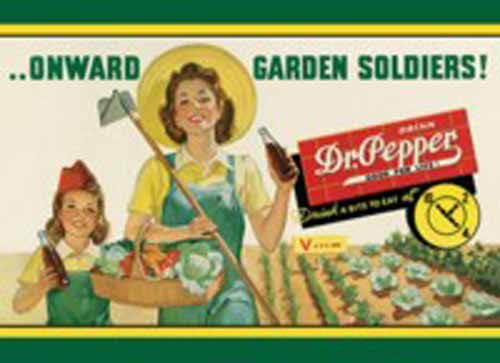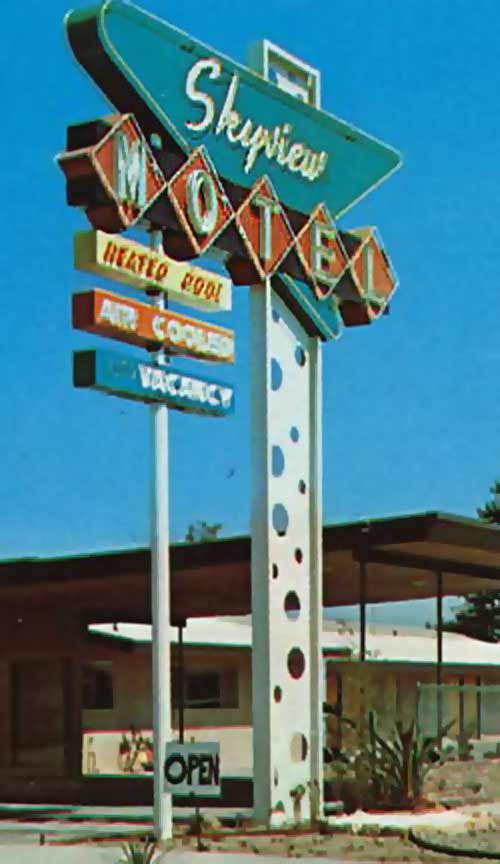
|
|
It was almost ninety on Saturday. Ninety! I cleaned out the potting shed, which always accumulates filth and spiders over the course of the year. It’s the place where we keep all the gardening equipment that brings life from Mother Gaia’s verdant breast, so naturally it smells like death: weed-killer, ant-killer, foul pungent fertilizer, powered coyote urine (I have an image of factory-raised coyotes, rows and rows, looked to small milking machines, force-fed beer) and everything else we use to make the flowers happy. The squirrels get in, looking for God knows what, and probably stagger out dizzy, leaping for branches that aren’t there. Well, it’s clean now. To celebrate its pristine state I put up a sign I’d bought at the State Fair: a mother and daughter planting vegetables for victory, enjoying a Dr. Pepper.
As I’ve said before: if the culture militarized 1/100th of the things it militarized in the 40s, people would think they were living in Nazi Germany. Even a soda-pop ad about gardening was turned to the war effort. They give us a nice warm glow now – ah, everyone was united! Everyone was on board. Everyone went out to cull cukes with a smile on their lips and an Andrews Sisters song in their hearts, or vice versa. But I suspect many tired of this by the middle of the war – tired of the war occupying every aspect of life, tired of having everything defined as war work, tired of the hectoring ads from the radio asking for dimes, tired of saving fats, tired of maps on the front page with big black arrows, tired of the low throbbing dread. On the other hand: to have a son in the service, and open up LIFE every week and the ads reflect a world that went on its merry way without a thought to the struggle, well, that would have been worse, no? The Sunday paper had an interview with Malcolm Gladwell, who is coming to town to tell everyone how New York solved its crime problem. He's a smart fellow and an engaging writer, and I was interested in what he had to say about crime. He made three points: cracking down on quality-of-life crimes, making underperforming students perform, and - well, guess. "Repairing the physical environment ... got the ball rolling. But what made permanent change is that after initial steps were taken, a series of institutions and individuals came forward and made the longer-term investments that are paying off now in New York. You might wonder if it’s possible to write about New York’s renaissance and mention one mayor and not include the word “Guiliani” in the piece. Well, there’s your answer: it can be done! Was the existence of these crime-prevention activities dependent on raising taxes? Like the number of licks it takes to get to the center of a Tootsie Roll, the world may never know. Gladwell goes on to praise charter schools that take underperforming kids and make them work hard: "Is it hard to have a carefree childhood when you go to school that much? Absolutely. But those who do realize it is their single best chance for a future. They've done what people at the bottom of the socioeconomic rung have done for millennia. They have made a sacrifice. That's a really important part of this. It doesn't just have to be those of affluence in Minneapolis making efforts to help those at the bottom. Those at the bottom have to make sacrifices as well." That last line may or may not be controversial, depending on who says it. Gladwell also condemned a “zero tolerance” attitude that penalizes people for an early misstep in their lives. Granted. But wasn’t the renaissance of New York based specifically in a zero-tolerance policy for the turnstyle jumpers, the squeegee men, and the rest of the broken-window issues that the city had let slide for decades? Are we going to have a better society if people who steal cars don’t get jail time until the fifth offense? Doesn't crime prevention require, well, arresting criminals, and putting them in jail for a while? Let's put it another way. Say everyone went to jail for a year for stealing a car so they could rip out the airbags and converters and sell them to a chop shop. First offence, ninth, no difference. What would be the effect on the prison population? It would probably go up. What would be the effect on the number of cars stolen? It would probably go down. I know it sounds like counterintuitive crazy-math, but it could work. I have a book called “American Signs,” purchased before Gnat was born, I think. I remember getting it at the Barnes and Noble in Eden Prairie Mall on a summer Saturday, sitting outside the mall waiting for my wife, watching the sun slide down, peering at the illustrations. It’s an academic treatise of motel signage, rather dry and overly analytical but well-illustrated and chock-full of juicy spot-on semiotic observations. For some reason I never read the author’s conclusions. I did today. She explains why the great neon roadside signs become vanished, and were replaced by smaller, utilitarian plastic signage: the Highway Beautification Act of 1965. “During the 1960s, the US government, under mounting pressure from a public upset with the proliferation of roadside ‘visual pollution, (I suspect the upset public was responding to upset writers writing upsetting stories in national news mags – ed.) began to exert its influence on the signmaking industry. ‘The nation’s visual image,’ wrote graphic designer Joseph Selame, ‘can deteriorate only so far before the lawmakers of the land will be called to action. . . .The more primitive a people, the more they are attracted by bright, big, shiny objects. Too many signs of the past indicate the primitiveness of the American people.’” I’d never thought of that, but it makes sense. This was before Venturi, before the commercial vernacular was recognized as an art form in its own right. How messy it must have seemed to the advocates of the clean, spare roads; how crass and vulgar, all those blinking stars and buzzing neon tubes and backlit enticements. TV. PHONE. POOL. The idea that these signs were actually examples of a uniquely American art form would have been met with rolled eyes and an exasperated sigh' The ideal road, apparently, was a feature-free corridor punctuated by rational International-Style pavilions every 42 miles, freed from the garish intrusion of commerce. I always thought that highway beautification meant planting flowers and not throwing fast-food bags out of the car where they might splatter at the feet of a phony Native American. But it was more than that. The beautiful world was a place into which messy bumptuous commercialism was banished from the theorist’s dream of the pure road, the pure environment, the pure thing uncontaminated by inconvenient assertions of alternate ideas. It seems silly now, but you can well imagine the annoyance: we give these people a smooth serene road, carefully designed to bring them from one planned community to the next with a minimum of visual friction, and the spoilers put up loud contentious honking signs that reeked of the Almighty Dollar. You know, ugly godless totems like this:
Well, we showed them. Our signs our primitive; the lawmakers must act. Jeebus. This is what annoys me to no end about the 60s, to cram it all into a tidy convenient decade; the overculture and the underculture ganged up on the great Middle, for different reasons but with equal gusto. The Middle was Crass, in the eyes of the overculture; Phony, in the eyes of the underculture. Now here we are a half-century later, and people will build websites detailing the few remaining examples of postwar roadside architecture, documenting the survivors, eulogizing their demise. No one organizes a petition to save a building the underculture built, because they didn’t build anything. Ah well. Onward Garden Soldiers.
New Match; buzz.mn is already up and going. See you there!
|
||||||||||||||||||||||
...




